Understanding Erectile Dysfunction (ED): Causes and Treatments
Erectile Dysfunction (ED) is a common issue affecting men worldwide, especially as they age. It’s defined as the persistent inability to achieve or maintain an erection sufficient for satisfactory sexual performance. While ED becomes more prevalent with age, it’s important to note that it is not a normal part of the aging process. However, aging can be associated with certain physiological and psychological changes that contribute to ED.
How Common Is Erectile Dysfunction?
According to the Massachusetts Male Aging Study (MMAS), a landmark research study, about 52% of men aged 40-70 reported experiencing some degree of ED. This makes it clear that ED is a common issue, but one that should not be overlooked or dismissed as inevitable.
Smoking and Erectile Dysfunction
One significant risk factor for ED is smoking. Smoking damages blood vessels, reducing blood flow to the penis, which can impair the ability to achieve or maintain an erection. For men concerned about their sexual health, quitting smoking is one of the best ways to reduce the risk of developing ED.
The Pathophysiology of Erectile Dysfunction
To better understand ED, it’s helpful to consider the basic mechanisms involved in achieving and maintaining an erection. There are three major types of failure that can occur:
- Failure to Initiate: This refers to issues with sexual arousal. ED of this type is often linked to psychological, neurological, or hormonal problems.
- Failure to Fill: This occurs when there is an insufficient blood flow to the penis, often due to vascular problems.
- Failure to Store: This type of ED happens when the blood cannot be kept in the penis to sustain an erection, often due to issues with the venous system.
Causes of Erectile Dysfunction
ED can have multiple causes, and understanding the underlying problem is key to finding the right treatment. The causes are typically classified into the following categories:
- Vasculogenic Causes
These relate to blood vessel issues that prevent proper blood flow to the penis. Conditions such as atherosclerosis (hardening of the arteries), hypertension, and diabetes can damage the blood vessels and lead to ED. This is one of the most common causes, especially in older men. - Neurogenic Causes
The nervous system plays a crucial role in achieving an erection. Conditions that affect the nerves, such as spinal cord injuries, multiple sclerosis, Parkinson’s disease, or even long-term damage from diabetes, can interfere with the signals that trigger an erection. - Endocrinologic Causes
Hormonal imbalances, especially low levels of testosterone (the male sex hormone), can lead to ED. Other hormonal disorders, such as thyroid issues or increased prolactin levels, can also affect sexual function. - Psychological Causes
Psychological factors such as stress, anxiety, depression, or relationship issues can contribute to ED. In younger men, psychogenic causes are often more prevalent, though they can affect men of all ages. - Drug-Induced Causes
Certain medications can cause or worsen ED. These may include drugs used to treat high blood pressure, antidepressants, antipsychotics, and some medications used for heart disease. If you suspect your medication might be contributing to ED, talk to your doctor about possible alternatives.
Approaching ED: Finding the Right Solution
Determining the cause of ED is critical to finding the right treatment. A thorough medical history, physical examination, and sometimes specific tests (such as blood tests, ultrasound, or psychological assessments) are necessary to diagnose the underlying issue.
Treatment of Erectile Dysfunction (ED)
Identifying the cause of ED is essential in choosing the appropriate treatment. This may involve reviewing medical history, performing physical exams, and sometimes additional tests such as blood tests, ultrasound, or psychological assessments.
Treatment Options for Erectile Dysfunction
Fortunately, there are several effective treatment options available for ED. These range from medications to advanced therapies, and the right choice depends on the cause of the dysfunction.
- Medications
The most common first-line treatment is the use of PDE5 inhibitors, such as sildenafil (Viagra), tadalafil (Cialis), and vardenafil (Levitra). These drugs work by enhancing blood flow to the penis, making it easier to achieve and maintain an erection. They are effective for many men and have a relatively low risk of side effects. - Hormonal Therapy
For men with low testosterone levels, hormone replacement therapy (HRT) may be recommended. Restoring normal hormone levels can improve libido and erectile function, but this approach is usually only effective in men with documented hormonal deficiencies. - Shockwave Therapy
Low-intensity extracorporeal shockwave therapy (LI-ESWT) is a newer, non-invasive treatment for ED. It involves using shockwaves to stimulate blood flow and repair damaged blood vessels in the penis. This therapy has shown promising results, particularly in men with vasculogenic ED, and can potentially restore natural erectile function over time.
Conclusion
Erectile dysfunction is a common issue that can affect men at any age, but it is not an inevitable part of getting older. It is associated with various physiological, psychological, and lifestyle factors, such as vascular health, hormonal levels, and stress. Understanding the underlying cause is crucial to choosing the right treatment, whether it’s medications, hormonal therapy, or newer options like shockwave therapy.
If you’re experiencing ED, don’t hesitate to consult with a medical doctor. Effective treatments are available, and addressing the issue early can help improve both sexual health and overall quality of life. Now available at Z by Zeniq.

